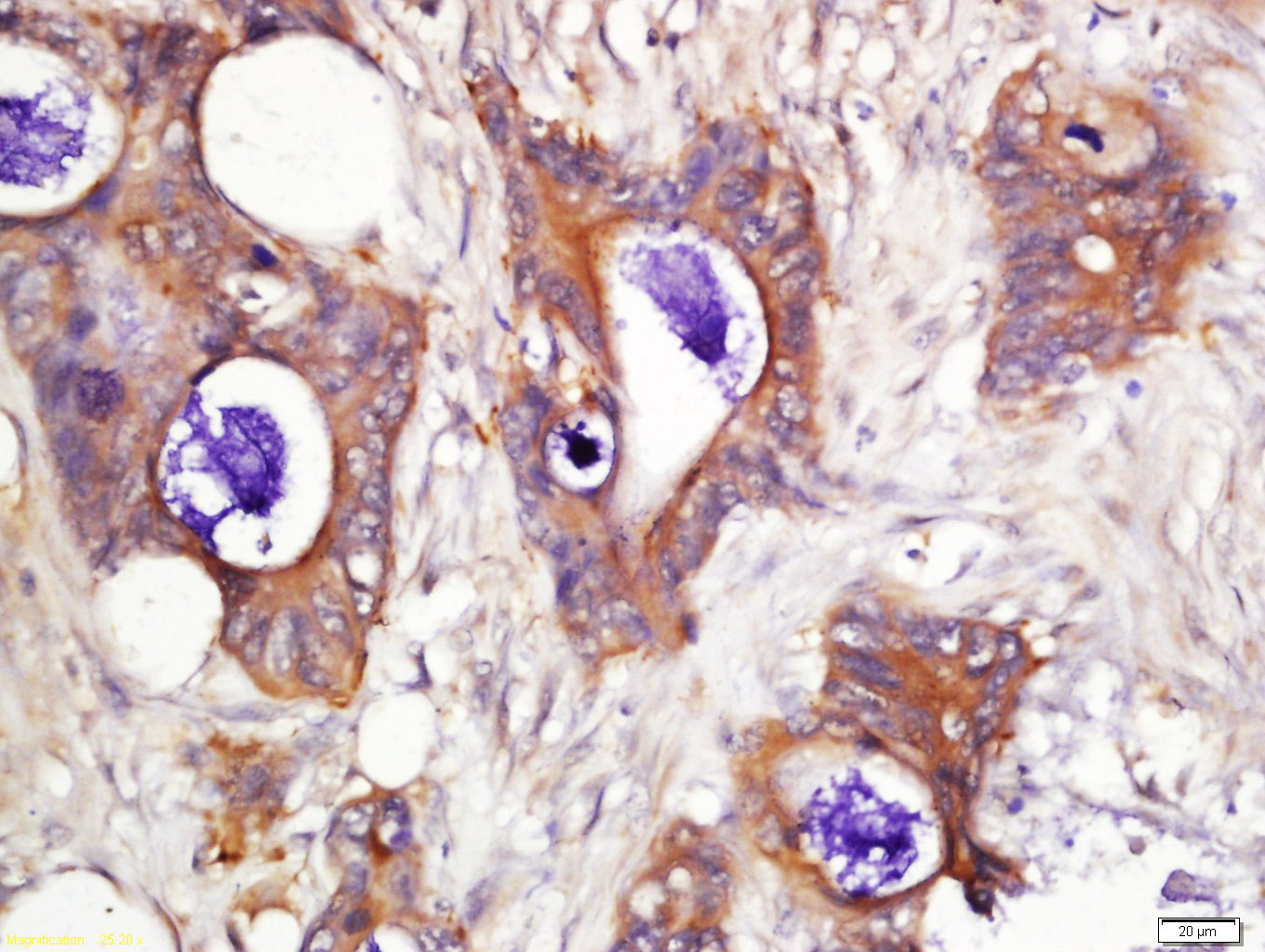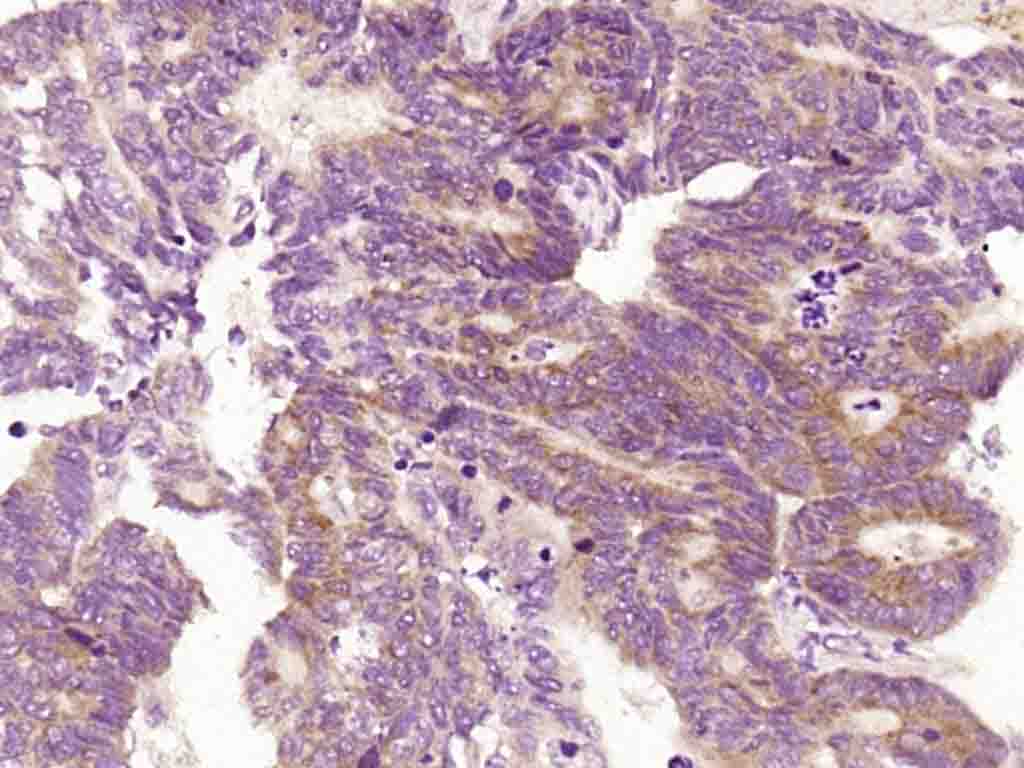
Rabbit Anti-AKT1S1 antibody
PRAS40; AKT1 substrate 1; AKT1-S1; AKT1S-1; AKT1S 1; AKT1 S1; Lobe; PRAS 40; PRAS-40; Proline rich akt substrate; 40 kDa proline rich AKT substrate; 40 kDa proline-rich AKT substrate; AKT1 substrate 1; AKTS1_HUMAN; MGC2865; Proline rich Akt substrate 40 k
View History [Clear]
Details
Product Name AKT1S1 Chinese Name 蛋白激酶AKT底物1抗体 Alias PRAS40; AKT1 substrate 1; AKT1-S1; AKT1S-1; AKT1S 1; AKT1 S1; Lobe; PRAS 40; PRAS-40; Proline rich akt substrate; 40 kDa proline rich AKT substrate; 40 kDa proline-rich AKT substrate; AKT1 substrate 1; AKTS1_HUMAN; MGC2865; Proline rich Akt substrate 40 kDa; Proline-rich AKT1 substrate 1. Research Area Tumour immunology transcriptional regulatory factor Kinases and Phosphatases Immunogen Species Rabbit Clonality Polyclonal React Species Human, (predicted: Mouse, Rat, Pig, Cow, Horse, Sheep, ) Applications ELISA=1:5000-10000 IHC-P=1:100-500 IHC-F=1:100-500 ICC=1:100-500 IF=1:100-500 (Paraffin sections need antigen repair)
not yet tested in other applications.
optimal dilutions/concentrations should be determined by the end user.Theoretical molecular weight 28kDa Cellular localization cytoplasmic Form Liquid Concentration 1mg/ml immunogen KLH conjugated synthetic peptide derived from human PRAS40: 161-256/256 Lsotype IgG Purification affinity purified by Protein A Buffer Solution 0.01M TBS(pH7.4) with 1% BSA, 0.03% Proclin300 and 50% Glycerol. Storage Shipped at 4℃. Store at -20 °C for one year. Avoid repeated freeze/thaw cycles. Attention This product as supplied is intended for research use only, not for use in human, therapeutic or diagnostic applications. PubMed PubMed Product Detail Proline Rich Akt Substrate (PRAS40) is a 40 kDa substrate of Akt. Akt and PRAS40 can be found in the phosphoinositide 3 kinase (PI3K) pathway, which plays a role in glucose uptake, cell growth, and apoptosis inhibition. PRAS40 is a 14-3-3 binding protein that reacts with insulin, but whose precise function is not yet known. It may bind SH3 and WW domain containing proteins resulting in a change of function. Activated Akt phosphorylates PRAS40 on threonine 246. Mutation of PRAS40 threonine 246 has been shown to be apoptotic.
Function:
Subunit of mTORC1, which regulates cell growth and survival in response to nutrient and hormonal signals. mTORC1 is activated in response to growth factors or amino-acids. Growth factor-stimulated mTORC1 activation involves a AKT1-mediated phosphorylation of TSC1-TSC2, which leads to the activation of the RHEB GTPase that potently activates the protein kinase activity of mTORC1. Amino-acid-signaling to mTORC1 requires its relocalization to the lysosomes mediated by the Ragulator complex and the Rag GTPases. Activated mTORC1 up-regulates protein synthesis by phosphorylating key regulators of mRNA translation and ribosome synthesis. mTORC1 phosphorylates EIF4EBP1 and releases it from inhibiting the elongation initiation factor 4E (eiF4E). mTORC1 phosphorylates and activates S6K1 at 'Thr-389', which then promotes protein synthesis by phosphorylating PDCD4 and targeting it for degradation. Within mTORC1, AKT1S1 negatively regulates mTOR activity in a manner that is dependent on its phosphorylation state and binding to 14-3-3 proteins. Inhibits RHEB-GTP-dependent mTORC1 activation. Substrate for AKT1 phosphorylation, but can also be activated by AKT1-independent mechanisms. May also play a role in nerve growth factor-mediated neuroprotection.
Subunit:
Part of the mammalian target of rapamycin complex 1 (mTORC1) which contains MTOR, MLST8, RPTOR, AKT1S1/PRAS40 and DEPTOR. mTORC1 binds to and is inhibited by FKBP12-rapamycin. Interacts directly with RPTOR. The phosphorylated form interacts with 14-3-3 proteins.
Subcellular Location:
Cytoplasm, cytosol.
Tissue Specificity:
Widely expressed with highest levels of expression in liver and heart. Expressed at higher levels in cancer cell lines (e.g. A-549 and HeLa) than in normal cell lines (e.g. HEK293).
Post-translational modifications:
Phosphorylated by AKT1. Phosphorylation relieves inhibitory function on mTORC1.
Similarity:
Belongs to the PDGF/VEGF growth factor family.
SWISS:
Q96B36
Gene ID:
84335
Database links:Entrez Gene: 84335 Human
Entrez Gene: 67605 Mouse
Omim: 610221 Human
SwissProt: Q96B36 Human
SwissProt: Q9D1F4 Mouse
Unigene: 515542 Human
Unigene: 148007 Mouse
Unigene: 102669 Rat
Product Picture
Antigen retrieval: citrate buffer ( 0.01M, pH 6.0 ), Boiling bathing for 15min; Block endogenous peroxidase by 3% Hydrogen peroxide for 30min; Blocking buffer (normal goat serum,C-0005) at 37℃ for 20 min;
Incubation: Anti-PRAS40 Polyclonal Antibody, Unconjugated(SL10176R) 1:200, overnight at 4°C, followed by conjugation to the secondary antibody(SP-0023) and DAB(C-0010) staining
Paraformaldehyde-fixed, paraffin embedded (human colon cancer); Antigen retrieval by boiling in sodium citrate buffer (pH6.0) for 15min; Block endogenous peroxidase by 3% hydrogen peroxide for 20 minutes; Blocking buffer (normal goat serum) at 37°C for 30min; Antibody incubation with (PRAS40) Polyclonal Antibody, Unconjugated (SL10176R) at 1:200 overnight at 4°C, followed by operating according to SP Kit(Rabbit) (sp-0023) instructionsand DAB staining.
Partial purchase records(bought amounts latest0)
No one bought this product
User Comment(Total0User Comment Num)
- No comment




 +86 571 56623320
+86 571 56623320




